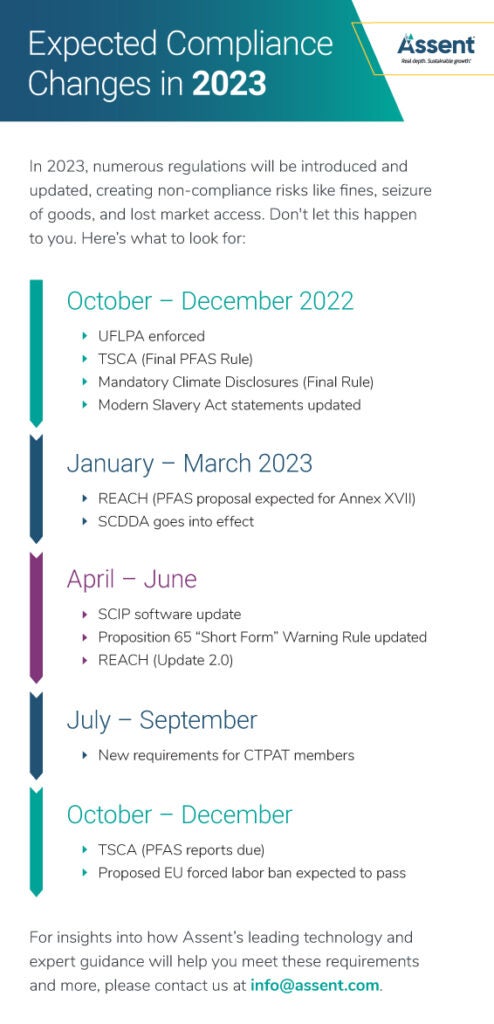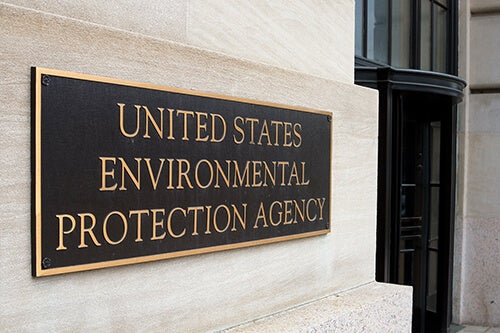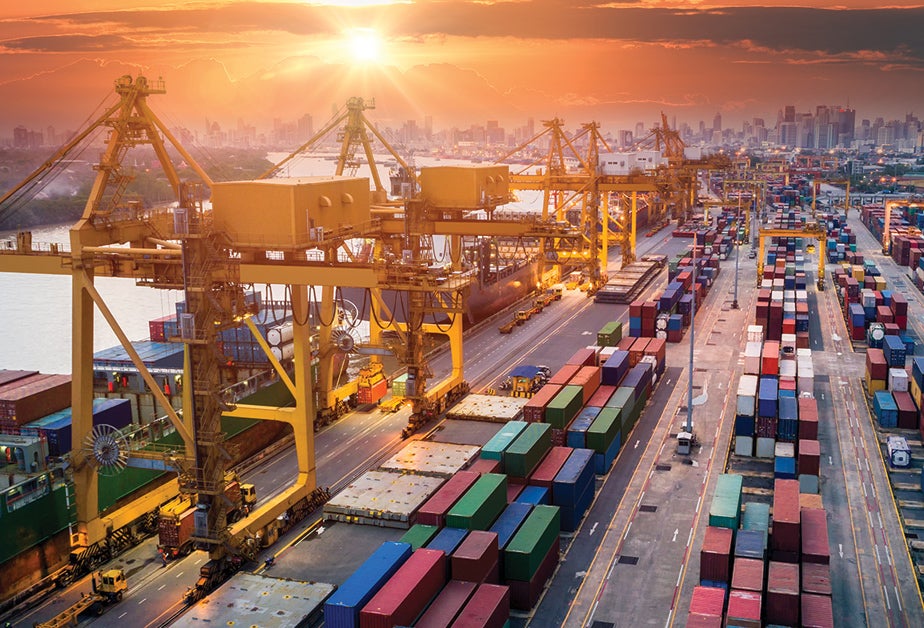In 2023, seven regulations will be either introduced or updated, creating new requirements for businesses and new areas of risk. Are you prepared to spend more time and money adjusting to these changes? If not, non-compliance with any of these regulations could result in fines, seizure of goods, lost market access, and loss of customer trust.
To help you prepare, we’ve compiled the most current information available about upcoming regulatory updates. With this article, you can start preparing for new requirements related to:
- The Toxic Substances Control Act (TSCA)
- The Customs Trade Partnership Against Terrorism (CTPAT)
- The EU Forced Labor Regulation
- The Restriction of Hazardous Substances (RoHS) Directive
- The German Supply Chain Due Diligence Act (SCDDA)
- The Registration, Evaluation, Authorisation, and Restriction of Chemicals (REACH) Regulation
- The Ecodesign for Sustainable Products Regulation (ESPR)
The Toxic Substances Control Act
Due to concerns from stakeholders surrounding the prevalence of this substance in modern supply chains, the Environmental Protection Agency (EPA) delayed enforcement of the PIP (3:1) restriction until October 2024.
However, manufacturers will need to be proactive in identifying and removing this substance ahead of this new deadline, given that removing this substance from supply chains will take substantial time.
And that’s not the only work manufacturers will have to do to maintain TSCA compliance in 2023. In June 2021, the EPA proposed Section 8(a)(7) to TSCA, requiring manufacturers to report PFAS usage all the way back to 2011, specifically regarding uses, volumes, disposal, hazards, and exposures. There is no “de minimis” exemption for smaller companies or those that use PFAS substances in small quantities.The EPA is expected to release a final rule by the end of 2022. Once released, companies will be responsible for gathering data and reporting on a wide range of PFAS substances – a task that will also take considerable time and resources.
The Customs Trade Partnership Against Terrorism
The Customs Trade Partnership Against Terrorism is a volunteer government-business initiative. It aims to build cooperative relationships that strengthen the international supply chain and U.S. border security.
New minimum security requirements related to forced labor were introduced in August 2022. Participants must now develop social compliance programs that ensure forced labor is not used in the production of goods that are imported into the U.S.
This will require extensive effort to satisfy, and companies should be prepared to provide U.S. Customs and Border Protection (CPB) with evidence that these plans have been implemented by August 2023. A few of those requirements include:
- Risk-based mapping of supply chain partners with regard to forced labor (suppliers and regions)
- Submitting evidence of implementation of social compliance programs (e.g., audits, internal training, etc.)
- Providing suppliers with training about their social compliance program requirements in order to identify and prevent forced labor in the supply chain
Aspiring members must have those plans in place before they apply to be a part of CTPAT.
For existing members, non-compliance will result in the loss of CTPAT membership, along with the benefits it provides (e.g., shorter wait times for goods coming into the U.S., front-of-the-line inspections, and priority business resumption in the event of a natural disaster).
EU Forced Labor Regulation
In September 2022, the European Commission proposed a new regulation that would prohibit products made with forced labor from being imported into or exported from the EU. Products made with forced labor would also be prohibited from being made available in the EU market. This regulation would apply to all levels of production and to all products.
This regulation, barring any delays, is expected to go into effect in two years, with hard requirements coming into effect in 2025. However, companies should start preparing in 2023 to comply with the rule that comes out of this proposal as it will require extensive and consistent effort.Manufacturers will need to build stronger supplier relationships, put forced labor data collection processes and educational opportunities in place, and create a method of identifying and filling data gaps, among other things.
Mandatory Climate Disclosures
In March 2022, the U.S. Securities and Exchange Commission (SEC) issued a proposed rule change that would require public companies to provide certain climate-related financial data and greenhouse gas emissions in public disclosure filings. A final rule is expected by the end of 2022.
Specifically, this rule would require three levels of disclosures:
- Material climate impacts (risks from physical climate-related hazards like fires and floods)
- Greenhouse gas emissions (reporting of audited scope one and scope two emissions)
- Targets and transition plans (disclose existing targets around emission reductions, energy usage, nature conservation, etc.)
Two of the key challenges companies face are poor quality of data and tracking and waiting too long to begin tracking and analyzing this data. Given the SEC rule’s scope and depth, companies will want to get started as soon as possible so they can be prepared to meet these disclosure requirements and not have to risk last-minute scrambling.
The German Supply Chain Due Diligence Act


On January 1, 2023, the SCDDA will go into effect. This act requires that all German companies with 3,000 employees or more take “appropriate measures” to respect the environment and human rights in their supply chain. The goal of this act is to reduce or eliminate risks associated with human rights and the environment, while also ending the violation of duties related to these issues.
On January 1, 2024, the scope of this act will be tightened to companies with 1,000 or more employees. Even employees that work abroad are included in this number.
Companies will be required to:
- File annual reports on due diligence activities
- Detail actions taken to identify risks
- Detail what steps were taken to address those risks
Companies will need to ensure their SCDDA compliance processes are robust enough to withstand scrutiny. Ineffective measures can lead to severe non-compliance penalties, like fines ranging from €800,000 or two percent of average annual global turnover for companies earning over €400 million, exclusion from government contracts, and lawsuits.
The RoHS Directive
The EU RoHS Directive is undergoing a revision process that could recast RoHS as a regulation instead of a directive. That would present new challenges for businesses, as a regulation would be consistent law for all member states, rather than requiring separate, and possibly inconsistent, transposition.
A survey of stakeholders also raised the issue of expanding the product list of in-scope electronic and electrical equipment (EEE) to include radio-frequency identification (RFID) technology and photovoltaic panels. In order to ensure their final product remains compliant, companies that use RFID technology and photovoltaic panels will have to survey their supply chain and ensure components and subassemblies do not contain any of the 10 restricted substances in quantities above threshold.
The RoHS Directive currently restricts 10 substances. An additional substance — tetrabromobisphenol A (TBBP-A) — will likely be added soon presenting manufacturers using EEE with new compliance budget and market access challenges.
Medium-chain chlorinated paraffins (MCCPs), which were expected to be added, may not be, as they are considered adequately covered under the REACH Regulation. Manufacturers will want to keep an eye on developments for these and other substances.
The REACH Regulation
The European Commission is planning to create a new European Audit Capacity (EAC) authority. This will give REACH enforcement bodies the ability to execute product recalls and recommended fines rapidly, along with other enforcement actions. It’s also expected that the next version of REACH will formally enshrine the EAC’s role and responsibilities.
In February 2023, the EU will restrict perfluoroalkyl carboxylic acids (PFCAs) through REACH as part of the Annex XVII Restricted List. All PFAS used in firefighting foams have also been proposed for restriction.
Companies will need to eliminate PFCAs from their supply chain while keeping a close eye on future PFAS restrictions. Since PFAS are prevalent in so many products, identifying them within your supply chain and eliminating them will take time.
Five countries are preparing a restriction proposal to cover a wide swath of PFAS substances. This proposal is expected in January 2023. While still a proposal, companies should, as with PFCAs, begin identifying and eliminating substances now to maintain future market access.
PFAS
Per- and polyfluorinated substances (PFAS) are coming under increased scrutiny across North America and the EU. Over 30 U.S. states have either proposed or passed PFAS legislation.
Colorado: In June 2022, HB22-1345 was signed into law. It establishes a regulatory scheme, collecting manufacturers’ information regarding PFAS usage in products. It also phases out the distribution of intentionally added PFAS substances starting January 2024. Manufacturers will want to prepare now for this phase-out process, as meeting these requirements will require extensive effort.
Maine: The Maine legislature passed An Act to Stop Perfluoroalkyl and Polyfluoroalkyl Substances Pollution, which includes a broader definition of PFAS substances than the 1,364 substances listed under TSCA. The latest legislation points to the EPA’s CompTox list, which includes more than 12,000 entries. Additionally, as of January 2023, Title 38 §1614 will require manufacturers to report products that contain intentionally added PFAS substances.
Overall, the regulatory trend on the state level is scope and requirement expansions. A law that was previously limited to drinking water may now be expanded to specific products, then to all products. Similarly, requirements are consistently expanding from reporting to restrictions. These trends are adjusting rapidly — as can be seen in Maine’s PFAS rule. Even manufacturers that feel their products are out of scope should be proactive in 2023, as they could easily be in scope sooner rather than later.
ESPR
In March 2022, the European Commission released a proposal for the ESPR. This proposal builds on the Ecodesign Directive, which only covers energy-related products, and is part of the Sustainable Products Initiative (SPI), and is expected to be the cornerstone of EU environmental policy. Its requirements will apply to all products and across the entire supply chain value.
The proposed framework will set requirements on:
- Carbon and environmental footprints
- Energy and resource efficiency
- Remanufacturing and recycling
- Recycled content
- Product durability, repairability, reusability, and upgradability
- Presence of substances that inhibit circulatory
Additionally, the ESPR will allow the EU to introduce labeling requirements, to create a digital product passport (including information linked to composition, chemical, and material properties and indications for repair).
In September 2022, the Competitiveness Council — part of the Council of the European Union — held a policy debate on the proposal. After this debate, the Competitiveness Council sees a need for additional negotiation and debate on several pieces of the proposal.
While the European Parliament still needs to produce a draft decision about the proposal, manufacturers will want to be proactive in preparing for the ESPR, considering its broad requirements and reach.
Stay Informed With Assent
The regulatory landscape is always shifting, incorporating new restrictions, laws, and product compliance needs. Keeping track of these changes can be both time-consuming and financially draining for complex manufacturers. With Assent’s solution, which is backed by our leading team of experts, you can stay on top of the landscape as it evolves, see deeper into your supply chain, and work more efficiently, protecting your company from significant risk.









